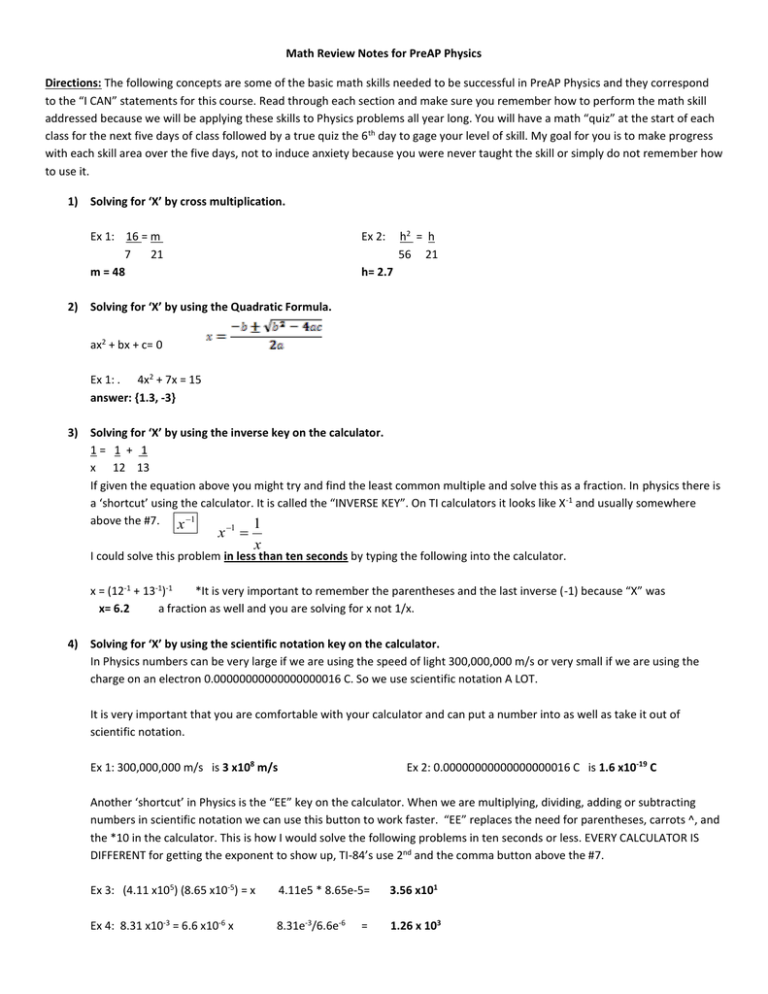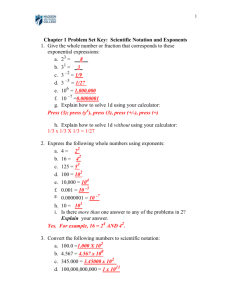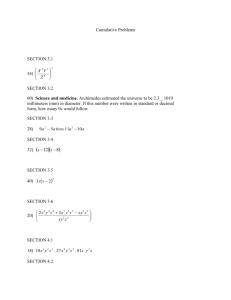Math Review Notes for PreAP Physics Directions: The following
advertisement

Math Review Notes for PreAP Physics
Directions: The following concepts are some of the basic math skills needed to be successful in PreAP Physics and they correspond
to the “I CAN” statements for this course. Read through each section and make sure you remember how to perform the math skill
addressed because we will be applying these skills to Physics problems all year long. You will have a math “quiz” at the start of each
class for the next five days of class followed by a true quiz the 6 th day to gage your level of skill. My goal for you is to make progress
with each skill area over the five days, not to induce anxiety because you were never taught the skill or simply do not remember how
to use it.
1) Solving for ‘X’ by cross multiplication.
Ex 1: 16 = m
7
21
m = 48
h2 = h
56 21
Ex 2:
h= 2.7
2) Solving for ‘X’ by using the Quadratic Formula.
ax2 + bx + c= 0
Ex 1: . 4x2 + 7x = 15
answer: {1.3, -3}
3) Solving for ‘X’ by using the inverse key on the calculator.
1= 1 + 1
x 12 13
If given the equation above you might try and find the least common multiple and solve this as a fraction. In physics there is
a ‘shortcut’ using the calculator. It is called the “INVERSE KEY”. On TI calculators it looks like X -1 and usually somewhere
above the #7. x 1
1
1
x
x
I could solve this problem in less than ten seconds by typing the following into the calculator.
x = (12-1 + 13-1)-1
*It is very important to remember the parentheses and the last inverse (-1) because “X” was
x= 6.2
a fraction as well and you are solving for x not 1/x.
4) Solving for ‘X’ by using the scientific notation key on the calculator.
In Physics numbers can be very large if we are using the speed of light 300,000,000 m/s or very small if we are using the
charge on an electron 0.00000000000000000016 C. So we use scientific notation A LOT.
It is very important that you are comfortable with your calculator and can put a number into as well as take it out of
scientific notation.
Ex 1: 300,000,000 m/s is 3 x108 m/s
Ex 2: 0.00000000000000000016 C is 1.6 x10-19 C
Another ‘shortcut’ in Physics is the “EE” key on the calculator. When we are multiplying, dividing, adding or subtracting
numbers in scientific notation we can use this button to work faster. “EE” replaces the need for parentheses, carrots ^, and
the *10 in the calculator. This is how I would solve the following problems in ten seconds or less. EVERY CALCULATOR IS
DIFFERENT for getting the exponent to show up, TI-84’s use 2nd and the comma button above the #7.
Ex 3: (4.11 x105) (8.65 x10-5) = x
4.11e5 * 8.65e-5=
3.56 x101
Ex 4: 8.31 x10-3 = 6.6 x10-6 x
8.31e-3/6.6e-6
1.26 x 103
=
5) Knowing the metric measurement system and can convert within specific prefixes.
kilohectodecabase
decicenti- millior
khdbdcm
*Most students have an acronym to help them remember the order such as “King Henry Died By Drinking Chocolate Milk”.
It is important to remember that “b” stands for base unit such as (meter, liter, and gram) In Physics we always convert our
measurements to METERS, KILOGRAMS, and SECONDS.
Ex 1: 675 g = _________ kg
0.675 kg
Ex 3: Convert 40 km/hr to m/s.
11.1 m/s
Ex 2: 1.2 km = ________ m
1,200 m
The most used prefixes in Physics are nano-(n), micro (μ), milli (m), centi- (c), and kilo- (k)
YOU NEED TO MEMORIZE THESE!)
Ex 4: 1 C = ________ nC
109
Ex 5: 1 μm = ________ m
10-6
Ex 6: 1 km = ________ m
103
6) Can determine the slope of a line from a given graph or equation.
7) Can determine the best fit line for a graph of specific data.
a. All measurements (data points) contain some amount of error because of the inaccuracy of our measurement
tools. So when we plot a graph of these points we do not ‘connect the dots’ to form a line, you’ll almost never get
a STRAIGHT line anyways.
b. We draw what is called a “BEST FIT LINE”. You draw this line with a ruler, placing in the middle of all the points,
making sure there are roughly even numbers of data points above and below the line.
c. THEN, you can use this line to calculate your slope, or relationship between the variables. You will be expected to
circle the two points on your best fit line that you are using to calculate the slope. It is WRONG to calculate slope
from data measurement points because they do contain error. Drawing the best fit line minimizes the amount of
error across all the points.
8) Solving for ‘X’ by using basic trigonometry. (We will really focus on this skill a little later, it will not be included in the first
set of “quizzes”.
SOH CAH TOA
sin
opposite
opposite
adjacent
tan
cos
hypotenuse
adjacent
hypotenuse
a 2 + b 2 = c2
Solve these triangles…
a. 7.8 b. 8.1 c. 6.4
d. 50 e. 4.0
f. 33.7o







